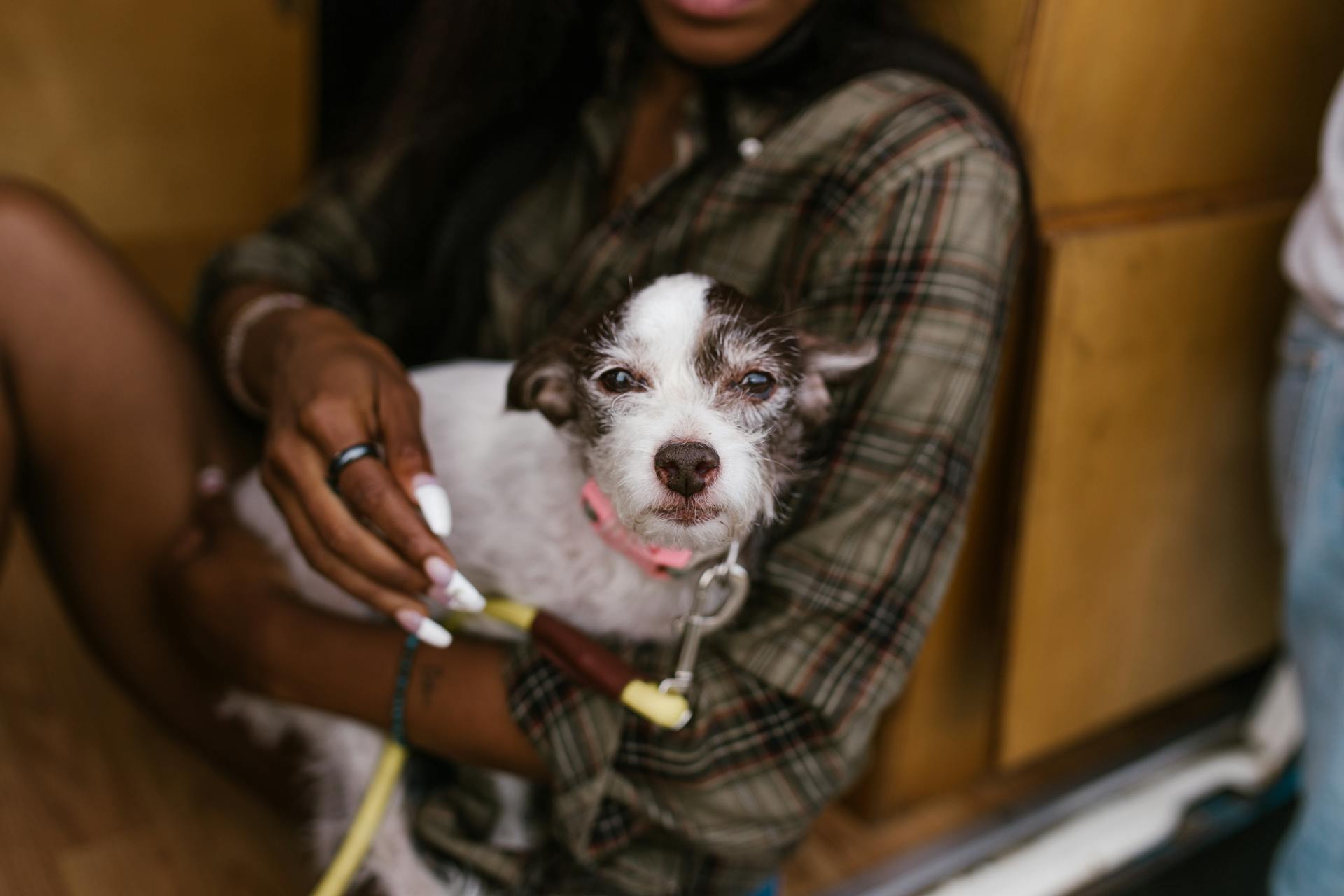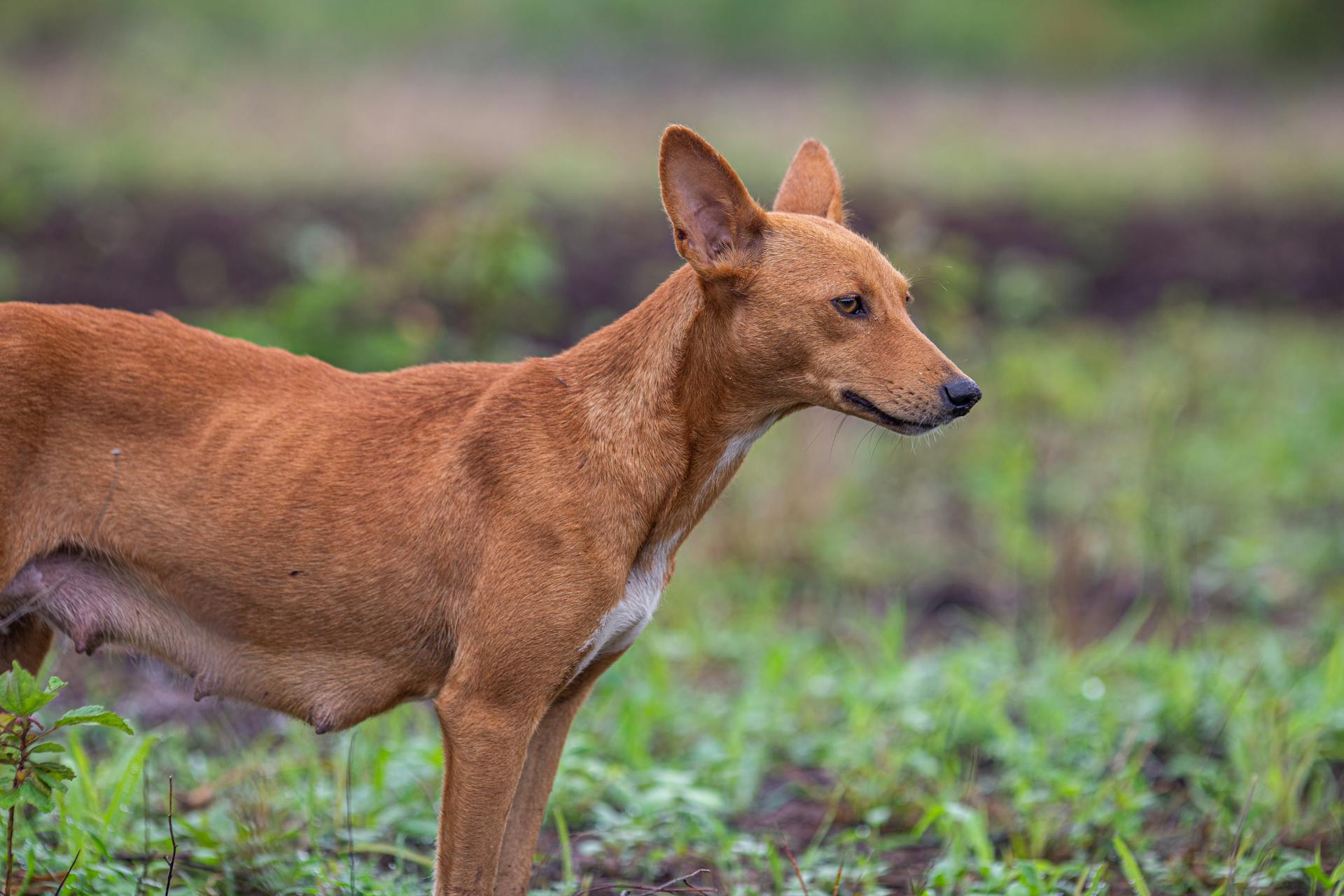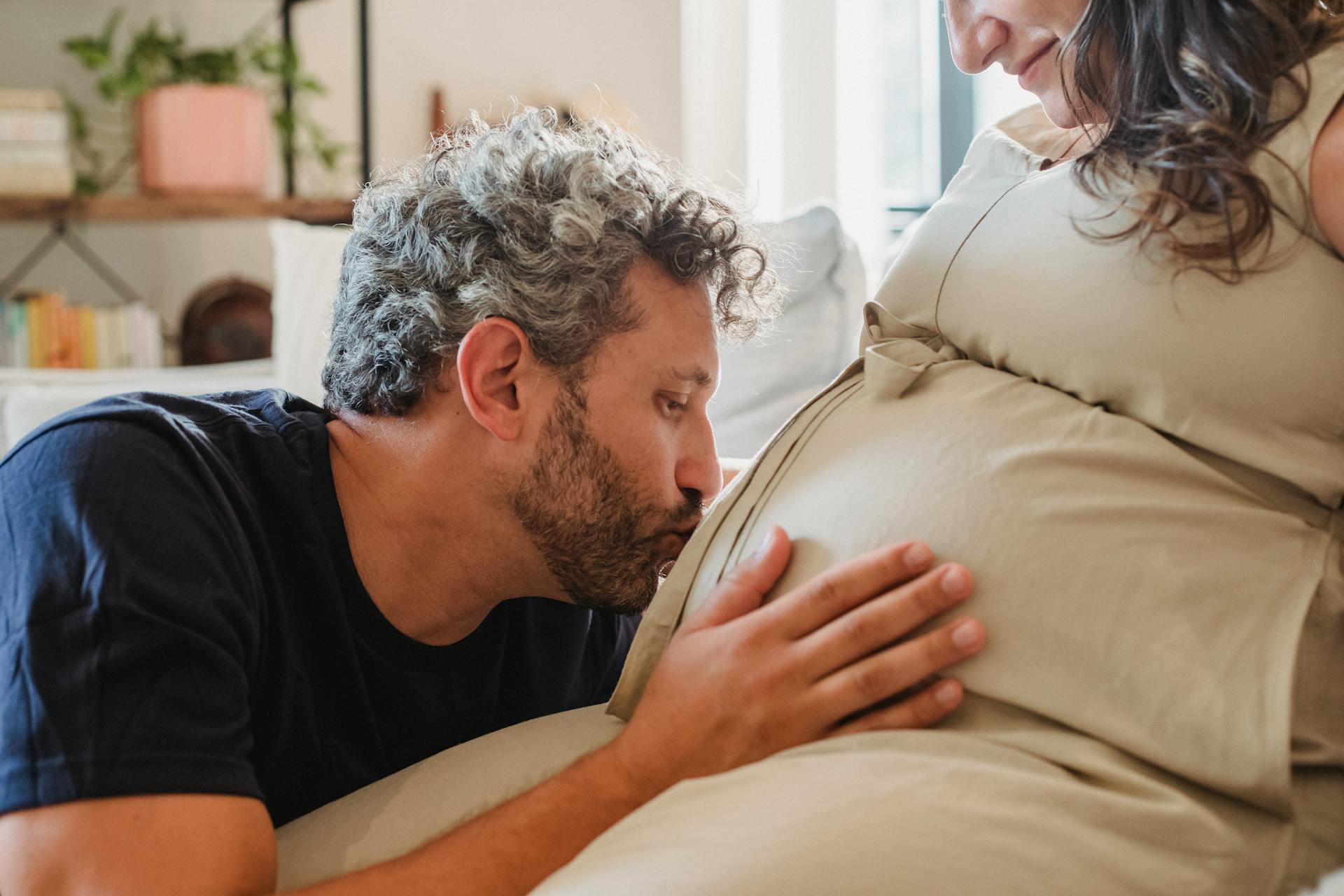
After mating, a female dog will typically enter a gestation period that lasts around 58 to 68 days.
During this time, she'll experience a series of physical changes as her body prepares for pregnancy. Her nipples will become larger and more prominent, and her belly will start to swell.
Keep in mind that each dog is different, and the exact duration of pregnancy can vary depending on factors like breed and size.
As your dog's pregnancy progresses, it's essential to monitor her health and adjust her care accordingly.
For another approach, see: Female Dog Phantom Pregnancy
Pre-Pregnancy and Pregnancy
After a dog has mated, it's essential to monitor her behavior and physical changes to determine if she's pregnant.
Around three to four weeks after mating, a veterinarian can perform an ultrasound or an X-ray to detect the puppies.
Early signs of pregnancy in dogs usually only start around three weeks after mating. These signs include behavioral changes like lethargy or clinginess.
Discover more: Signs That a Female Dog Wants to Mate
Irritability with other dogs is another common sign of pregnancy in dogs.
Enlarged nipples that change color are a physical indicator of pregnancy in dogs.
Changes in appetite are a normal part of pregnancy in dogs.
Some dogs may experience vomiting during early pregnancy.
A swollen midriff or weight gain from water retention are also signs of pregnancy in dogs.
Related reading: Female Dog Pregnancy Stages
Physical Changes
Pregnant dogs may look like they've gained weight, but this is usually just fluid retention in the beginning.
Real weight gain only starts in the final three weeks of pregnancy.
Both overweight and underweight mothers pose a risk to themselves and their puppies.
You'll need to see a vet 4 weeks after conception to confirm the pregnancy.
X-rays should also be taken to know how many puppies to expect.
Weight gain is another physical indicator of pregnancy, as the embryos develop and grow.
However, it's essential to note that other factors, such as overfeeding or lack of exercise, can also cause weight gain.
Readers also liked: Sudden Weight Gain in Female Dog
Behavior and Health
After mating, your female dog's behavior may change in various ways. She may become more affectionate, seek solitude, or exhibit nesting behavior.
Some dogs may become more impatient and snappy with other dogs, so it's a good idea to give her more space. This is especially true if she's becoming more clingy and needy.
Behavioral changes in dogs after mating can be unpredictable and depend on the individual dog. You may notice her becoming more lethargic and preferring to nap most of the time. On the other hand, she might become significantly sweeter or gentler.
Here are some potential behavioral changes you may observe in your female dog after mating:
- Becoming more impatient and snappy with other dogs
- Becoming more clingy and needy
- Becoming more lethargic and preferring to nap
- Becoming significantly sweeter or gentler
Hormone Tests
Hormone Tests can be a reliable way to confirm pregnancy in dogs, measuring progesterone levels in the blood, which rise during pregnancy.
These tests can be performed as early as 21 days after mating, providing an accurate indication of pregnancy.
A sudden drop in progesterone levels can indicate that the dog has given birth, making hormone tests a valuable tool for monitoring the health of pregnant dogs.
Expand your knowledge: Pregnancy in Chihuahuas
Nausea and Vomiting

Pregnant female dogs can experience morning sickness, which means they may vomit at any time, not just in the morning. This usually happens during the third and 4th week after conception.
Their hormones are fluctuating, causing them to vomit for a few days. It's essential to keep an eye on this and make sure she stays hydrated.
Increased Appetite
Increased appetite is one of the earliest physical indicators of pregnancy in dogs. This is because the growing embryos require more nutrients to sustain their development.
Some dogs experience a sudden increase in appetite, eating more than usual. This can be a sign that she is pregnant.
A balanced diet is essential to meet your dog's nutritional needs during pregnancy. Providing the right food will help support the growth of the embryos.
Increased appetite can vary from one dog to another, with some becoming more selective or even experiencing a temporary decrease in appetite.
Behavior

After mating, you may notice some changes in your female dog's behavior. She may become more affectionate, seek solitude, or exhibit nesting behavior.
These behavioral changes are natural and indicate her instinctive preparation for motherhood. Behavior changes in dogs after they have mated really depend on the individual dog.
Some common changes you may see include:
- Becoming more impatient and snappy with other dogs;
- Becoming more clingy and needy;
- Becoming more lethargic and preferring to nap most of the time;
- Becoming significantly sweeter or gentler.
In many dogs, you may not notice any major behavioral changes at all, especially in the first few weeks.
Gestation and Whelping
Pregnancy in dogs typically lasts around 63 days, although it can vary. Your vet can confirm gestation around day 25 using an ultrasound or blood test to determine the level of relaxin, a hormone only created by the placenta.
To prepare for whelping, it's essential to have a whelping nest set up in a quiet place, with a temperature of around 24-26°C during the first week. You should also have a tub of baby dog milk available, in case the mother struggles to produce milk.
For your interest: Female Dog False Pregnancy
Here's a checklist to ensure you're prepared for whelping:
• Whelping nest is set up in a quiet place in the house.
• Whelping room temperature: around 24-26°C during the first week.
• Tin of puppy milk in stock, just in case.
• Clean linen and/or towels, to change the bed after whelping.
• Disposable gloves.
• Kitchen paper.
• Scales to weigh the puppies.
Note down the phone number of your vet, as they can provide guidance and support during this critical period.
For more insights, see: When Can a Female Dog Get Pregnant during Heat
Understanding Pregnancy
Pregnancy in dogs typically lasts around 63 days, although it can vary. This gestation period is initiated once conception takes place, and the embryos migrate and attach to the uterus.
To confirm pregnancy, visit your vet around day 25, as they can perform an ultrasound to establish a reliable diagnosis. This will give you some idea of the size of the litter, as well as potentially detecting any abnormalities.
The most obvious sign of successful dog mating is the presence of a "tie" between the male and female dogs, which can last for several minutes. Another sign is pregnancy, which can be confirmed through veterinary methods.
Physical changes in the female dog can start to appear around three weeks after mating, including behavioral changes, enlarged nipples, changes in appetite, and vomiting. These signs can be followed by a swollen midriff or weight gain from water retention.
A veterinarian can confirm pregnancy through ultrasound scans, X-rays, or hormone tests. Ultrasound scans can be performed as early as 25-30 days after mating and can estimate the number of puppies present.
Here are some key things to have ready for whelping:
- A whelping nest set up in a quiet place in the house
- A tin of puppy milk in stock, just in case
- Clean linen and/or towels to change the bed after whelping
- Disposable gloves
- Kitchen paper
- Scales to weigh the puppies
- Note down the phone number of your vet
Whelping (Giving Birth)
Whelping, or giving birth, is a crucial process for any dog owner to understand. Once the first puppy is delivered, it's essential to check if the foetal sack needs to be torn open, which can be done by the owner wearing disposable gloves over clean hands.
Typically, most puppies will be born within 1-2 hours of the last puppy. Some variation can occur, but this is a general guideline to expect.
It's normal for some puppies to be born with their back feet first, often incorrectly described as the "breech" position. This is actually when the bottom is delivered first, with back feet tucked forwards.
A unique perspective: When Does a Female Dog Have Her First Heat
Health and Care
During pregnancy, your dog needs a nutrient-rich diet to support her own health and the development of her puppies. A balanced and complete dog food should be the main staple of her diet.
Pregnant dogs require more calories to support the growth of their puppies, so you may need to increase the amount of food you're feeding her. This is especially true during the last trimester of pregnancy.
Proper nutrition is crucial for your dog's health and the development of her puppies.
Consider reading: Female Dog Names for Small Dogs
Veterinary Confirmation
Veterinary Confirmation is key to ensuring the health and well-being of your dog and her potential puppies. Confirming gestation, or pregnancy, is crucial for proper monitoring of your dog's condition.
Your vet can perform an ultrasound around day 25 to establish a reliable diagnosis of pregnancy, giving you an idea of the size of the litter. Alternatively, a blood test can detect the level of relaxin, a hormone only created by the placenta.

It's essential to confirm your dog's pregnancy as early as possible to ensure timely monitoring of her condition. This will also give you a chance to prepare the whelping area, including having enough dry linen and an extra heater to maintain an ideal temperature.
Your vet is the most reliable source for confirming a successful mating in dogs, and they can use various methods such as ultrasound scans, hormone tests, or X-rays to do so.
Recommended read: Dog Names Female Start with S
Rest After
Rest is crucial for a pregnant dog's well-being. She needs a quiet and cozy spot to relax, which can be a soft bed or a designated area where she feels safe and secure.
Pregnant dogs require more sleep, so let her take those well-deserved naps. Make sure she has a quiet area where she won't be disturbed.
Minimizing loud noises, sudden movements, and stressful situations can prevent anxiety in pregnant dogs. A calm and peaceful environment is essential for her well-being.

Regular veterinary check-ups are vital to ensure the pregnancy progresses smoothly. Your vet can guide rest and activity levels specific to your dog's needs.
Here are some tips to create a restful environment for your pregnant dog:
- Set up a quiet and cozy spot for your pregnant dog to relax.
- Minimize loud noises, sudden movements, and stressful situations.
- Make sure she has a quiet area where she won't be disturbed.
Nutrition and Supplements
Your dog's nutrition plays a crucial role in her health and the development of her puppies. Proper nutrition is essential during pregnancy.
Feed your dog a high-quality dog food that meets her nutritional needs. You can consult with your veterinarian to determine the best food for her.
As your dog's belly grows, she may need more calories to support her pregnancy. Increase her food intake by 20-30% to meet her increased energy needs.
Pregnant dogs also require more protein, calcium, and other essential nutrients. A well-balanced dog food will provide these nutrients.
Some pregnant dogs may benefit from supplements, but always consult with your veterinarian before adding any supplements to your dog's diet.
Heat Cycle and Mating
A female dog's heat cycle is a critical phase in her reproductive life, and understanding it is essential for breeders and dog owners. The heat cycle is typically 21 days long, and the female dog is fertile for 3-5 days during this time.
The heat cycle is divided into four phases: proestrus, estrus, diestrus, and anestrus. Proestrus is the beginning of the heat cycle, characterized by swelling of the vulva and a bloody vaginal discharge. This phase can last anywhere from 7 to 10 days.
During estrus, the female dog is receptive to mating and is fertile for 3-5 days. The vaginal discharge changes in color and consistency, becoming lighter and straw-yellow or clear. This is often a sign that the female is ovulating and is the optimal time for mating.
A successful mating is often indicated by the tie, where the male and female dogs are physically attached for a period of time. The timing of the mating is also crucial, as mating during the fertile part of the cycle increases the chances of success.
A unique perspective: How Often Do Male Dogs Go in Heat
Here's a summary of the heat cycle phases:
By understanding the heat cycle and the timing of mating, breeders can increase their chances of a successful breeding.
Return
After mating, it's essential to give the couple some space and not try to separate them, as this can cause damage.
The lock phenomenon can keep the two dogs together for 15 to 30 minutes, which may look odd to us, especially if the male does a 180-degree turn.
Fertilisation may not be successful even if mating has taken place, as the bitch's fertility may not have reached its peak at the time.
Mating is often carried out twice, with a two-day interval between attempts, to increase the chances of a pregnancy occurring.
The fertilised egg is the first component of a new living being, and it's an exciting time in the heat cycle.
The embryos start off very high up in the uterus, but towards the end of the first week, they migrate down towards the uterine horns.
The sperm can survive in the uterus for up to seven days, so fertilisation may take place several days after mating.
Expand your knowledge: Female Dog Not Spayed
Is It Normal? - Pets
Is It Normal?
It's normal for a female dog to bleed after mating, but it's not always a cause for concern. This bleeding can last for a few days.
The bleeding is usually due to the vaginal reflex that traps the male dog during mating, which can cause some discomfort and bleeding. The male dog's size can also contribute to this bleeding, especially if the female dog is a virgin.
The chances of a successful mating are high, but it's not a guarantee. The timing of the mating is crucial, and females are typically fertile for only 3-5 days during their 21-day heat cycle.
If you're planning to breed your dog, it's essential to ensure that the mating occurs during the fertile part of her cycle. Most matings are successful unless the male or female dog has a fertility problem.
Here's a rough estimate of the timing of a successful mating:
Keep in mind that every dog is different, and the success of a mating can depend on various factors. If you're concerned about your dog's health or the mating process, it's always best to consult with a veterinarian.
Heat Cycle Phases
A female dog's reproductive cycle is called an estrous cycle and is broken down into three different phases: proestrus, estrus, and anestrus.
Proestrus is the beginning of the heat cycle, characterized by swelling of the vulva and a blood-tinged vaginal discharge. This phase can last anywhere from a few days to four weeks, with an average duration of seven to 10 days.
During proestrus, the female dog may have bloody vaginal discharge and attract male dogs, but she is typically not receptive to mating.
The estrus phase, also known as "heat", is when the female dog will allow mating to occur. This phase lasts anywhere from three to 21 days, with an average length of nine days.
After the estrus phase, the dog enters diestrus, where the vaginal discharge may become reddish again or cease altogether. The female is no longer receptive to males during this stage.
Anestrus is the period of sexual inactivity between heat cycles, with no noticeable vaginal discharge observed during this phase.
Here's a quick breakdown of the heat cycle phases:
Frequently Asked Questions
Can you tell if a female dog has been mated?
To confirm if a female dog has been mated, a scan is typically required 3 weeks after the possible mating. Alternatively, a medication called Alizin can be administered to prevent pregnancy if desired.
Why is my dog acting strange after mating?
After mating, female dogs may exhibit unusual behavior such as lethargy, changes in gait, and standoffishness due to physical discomfort. If you're concerned about your dog's post-mating behavior, read on to learn more about what to expect and how to care for her
Can you fix a female dog after mating?
Yes, spaying a female dog after mating is possible, but it's a more complex procedure involving the removal of both ovaries and the uterus. If you're unsure, consult a veterinarian for guidance on the best course of action for your dog's health and well-being.
Sources
- https://pawsafe.com/blogs/dog-healthcare/what-to-expect-from-female-dog-after-mating
- https://www.baldivisvet.com.au/your-dogs-pregnancy-week-by-week/
- https://www.petmd.com/dog/general-health/dog-in-heat
- https://pawsafe.com/blogs/dog-healthcare/how-to-know-if-dog-mating-is-successful
- https://www.nairaland.com/2588533/urgent-female-bleeds-after-mating....is
Featured Images: pexels.com


